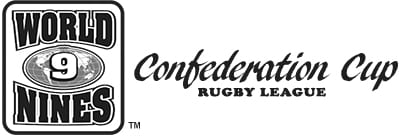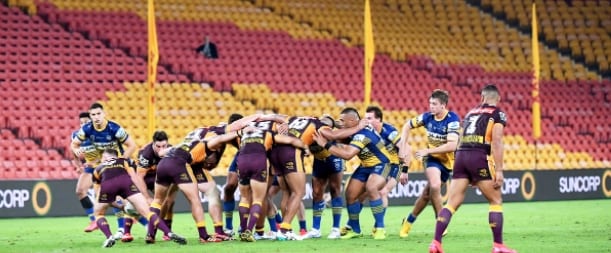The rugby league scrum has always been an area which the fans have enjoyed or voiced their disapprovals about for over 110 years, including the call for ‘Push harder’ and the endless call from fans for a penalty to be awarded to their team.
“I know in our scrums we don’t push anymore, but it is so important to keep six in a tight group to give you more attacking space,” Gordon Tallis said on Triple M’s Sin Bin. Gordon’s assertion on the value of the scrum must be given some consideration, given his long experience competing at every level of the game.
This is written with perhaps a little tongue in cheek, but as General Patton said “A good plan today is better than a perfect plan tomorrow.”
Before comparing Rugby League to other ‘Games’ one should first recognise that Rugby League is a continually evolving sport in many ways, driven by the players, the fans, and the media. Rugby, Basketball, Baseball, Cricket on the other hand are all invented games, and consequently tradition and heritage are retained in most cases when it comes to whether changes are necessary to the laws of those invented games.
The NFL and Rugby League know that they must address their rules of the game when the fans, through media channels and social media, express their concerns, particularly regarding player safety. The NRL as the governors of the sport in Australia have acted professionally during Coronavirus in getting bums on lounges and seats. However, it then becomes the role of those who have the responsibility to not only win games but produce associated entertainment value, to get those bums jumping up in anticipation. The NRL fortunately understands that it must always be presenting a game that is a better game and more entertaining than any other sport.
1895 and the Northern Union (NU)
In 1895 when Northern Union (NU) broke away from Rugby they decided to address three major changes to distance the ‘new game’ from Rugby.
Firstly, reducing the number of players on the field from 15 players to 13 was achieved by limiting rugby league’s scrum to six players, therefore eliminating the positions of the two Flankers.
N.U. then elected to bring the ball back into play by the ‘play the ball movement’ rather than the rugby ruck, and at the same time they also eliminated the Lineout.
The NSW RL adopted these rules in 1908 and continues to address the laws of the game to ensure player safety is at a premium.
Reasons for the evolution of the uncontested scrum.
The NSWRL/ARL and now the NRL continue to investigate improved player safety and to write laws of the game in regard to incidents of lifting, recklessly carelessly or needlessly in regard to neck or head, dangerous contact, dangerous throw, and the shoulder charge. The catalyst for a discussion on the scrum was after a severe neck injury to a schoolboy player in Wollongong.
The decision was made to implement compulsory accreditation for every rugby league coach, The National Coaching Accreditation Scheme -NCAS) was established by the ARL, and demonstrated the duty of care concerns of that League. Next, the field runner was required to wear a yellow singlet, whilst the NRL First Aid Accredited person wore a blue singlet.
In conjunction with the Westpac helicopter service the NSWRL conducted a simulated transport by air of a suspected spinal injury to Prince Henry Hospital. This simulation was called Necksafe.
The scrum also came into the discussion in relation to wheeling, but the decision to introduce an uncontested scrum to make the game safer, was carried in 1993 at a full NSWRL meeting.
Don Furner Snr. opened the debate on ‘No Contest Scrum’ (NCS) at the NSWRL based on facts, submissions, and observations, as it had also become a matter of concern by the players, the fans, and the media. Documentation was presented regarding the lack of action on the field of play, before reviewing results from numerous scrums.
The data was collected and held at the NSWRL, including the following:
- Player safety particularly in relation to the neck
- Penalties from scrum infringements were increasing
- The 7 and 9 conducting private contests with referees
- Time taken out in endless resetting of scrums
- Second row feed lose head prop, outside foot up, all penalties.
- Hookers feet across the funnel
- Half backs baulk when feeding the scrum
In addition, it was noted that there was a great amount of time being spent at training on scrummaging.
The laws of the game, to be fair, do ensure that the advantage in a scrum should go to the team which does not incur the minor infringement. A contested scrum does give some advantage to the non-offending team, even to the extent that they could receive an ensuing scrum penalty.
The NFL does not contest the Snap in their Lineout.
Rugby scrums favourably advantage the team which does not infringe.
Rugby League can rightfully pride itself on introducing spontaneity in 2020, but a return to the contested scrum will not contribute to the growing entertainment value of the game.
Should the contested scrum be considered for reintroduction, then the profile of the front row may also need to change. The contested scrum is a show of strength, and those who play in the front row in today’s game are big and mobile and they will therefore incur an additional workload in a contested scrum against people just as big and just as strong as themselves. Their bench recovery time may therefore be longer.
The rugby league scrum is not the fabric of the game… it’s more of a ‘Huddle’ and it is unlikely that scrimmages such as we see in the NFL will work in a game as fast flowing as rugby league. Also, many rugby league fans are not fans of the line of scrimmage which defines the NFL.
We should, as Gordon Tallis indicated ‘tighten the group’. How this can be done without further pressure on the referees must be taken into consideration.
Conclusion
It is all very well to say that we should be innovative and find a better way to bring the ball back into play regarding the scrum, but options are limited.
However, in my opinion it is not a scrum. It should be renamed, as the scrum defines Rugby, and as Rugby League expands globally it becomes increasingly important for the rugby league brand to be differentiated. The rugby league scrum began to lose its relevance when limited tackles were introduced, and further when turnovers added to their lack of importance as a deciding factor on the scoreboard.
I see it as a ‘Huddle Formation’.
Discussion points
One: Revert to contested scrums. (Not for me).
Two: Players just leaning on the second rowers sends a poor image to fans, as the rest of the game portrays ultimate professionalism by comparison. When the front row player takes the first pass from a scrum it undermines the argument that a scrum “keeps forwards out of the backline”.
Scrums were once launched as an attacking move and this is undermined by loose packing and forwards breaking far too soon. The law of the game states that “If, in the opinion of the Referee, a team deliberately does not attempt to pack a scrum, a penalty will be awarded to the non-offending team at the mark. This will not be a differential penalty. Properly Bound and Packed means all players in the scrum bound together, both teams packed together and the half back ready to feed the ball into the scrum. Stoppage, for the purposes of the “scrum clock”, means a scrum, drop out, 20 metre restart or a handover”.
Note: Uncontested scrum is not a written law in the law book. It is an interpretation or “by a law of common direction /instruction and usage”.
Three: The Scrimmage Line
If it was rugby league, then we would have at least 6 players on the line, but the similarity between the two games of NFL/NRL is in the transference of the ball by the ¼ back to the wide receiver by hand in the NFL, which is duplicated in rugby league by the half kicking the ball to his winger. The foot replaces the hand. In NFL they are allowed one forward pass in the set but can lateral as often as they wish. However, there are two dominating factors that prevent this from occurring. One is the incompletion of the pass, meaning that they have turned the ball over. The other factor is that the helmet intrudes so far across the cheek that the ball carrier cannot see the receiver unless they do a full half head turn. Try it with your hands and you will see what I mean. Furthermore, many NRL fans are not necessarily NFL fans, and it was a form of scrimmage that the NU eliminated in 1895 anyway.
Four: The present formation and laws of the game continue to be observed and enforced without change, but with players breaking from formation far too soon as no related strength is needed, they should be addressed, and not as a differential.
Changes to laws of a game that is continually evolving are necessary, particularly in relation to those laws which relate to the set plays that come into motion when the scrum is in motion, and six players are or can be out of the defensive line.
The scrum no longer has such relevance, influenced by changes to the laws of the game becoming less frequent up until limited tackles were introduced. Law change to the scrum should not increase the 44 seconds that data confirms is the time that begins from the referee signalling the minor infringement, to the ball leaving the half back’s hands into the ‘Huddle’ that can then activate the scrum.
Don Furner and I worked together in those years. He was a wonderful astute lover of the game and he strongly believed in the non-contested scrum (NCS). He also took advice from his associate at NSWRL- former international referee Michael Stone. I fully supported the proposal at the NSWRL meeting which introduced the NCS.
This is a chat between people who care about an enigmatic ever evolving game. Many contribute directly, but there are those who may see an option even though they do not fully understand the intricacies of the game.
To those of you who do not need the whole staircase let us- just take the first step and see where it will take us.
Paul Broughton OAM

